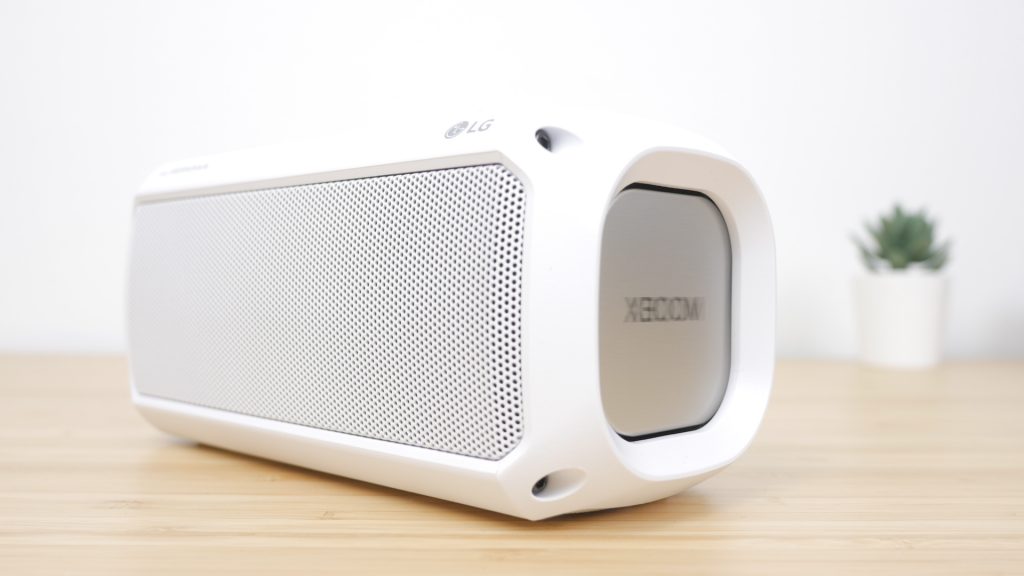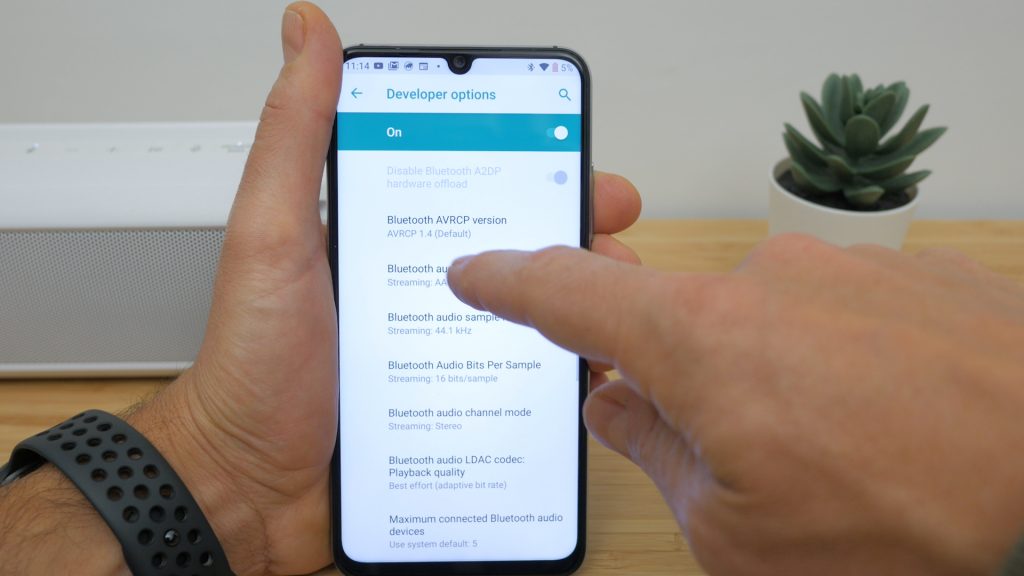LG’s PK3 XBOOM Go is the smallest of the XBOOM Go trio; the largest PK7 I reviewed just recently. For all three speakers, LG has partnered with Meridian – an British audio specialist manufacturer to try and deliver the best sound possible. It’s missing a few features of its larger siblings, namely party mode where you can link multiple speakers; and their various lighting modes, but it’s far smaller and it has an IPX7 waterproof rating rather than their lesser IPX5.
It retails at around £99 but it’s very often reduced to half this price on Amazon so check the link below. Could this be the perfect compact Bluetooth speaker? I’ll be comparing its output to some similarly sized speakers: the JBL Flip 4, the Anker SoundCore Boost, the Tribit MaxSound Plus and the Tronsmart Force. And I’ll also include the larger but similarly priced Anker Motion+ for good measure. Let’s find out how it measures up!
Overview

Inside the box you get the speaker itself, a USB-C to USB-A charging cable and a brief instruction manual. I’m pleased to see the latest USB-C charging. There’s no 3.5mm auxiliary cable or travel pouch.
This is a small speaker and could be perfect for travel, although may be a little on the heavy side. It weighs 742g and measures 182mm x 82mm x 82mm.
This newer model comes in white but there’s also a slightly older model available in black. The internals haven’t changed. I like the design which looks both contemporary and rugged.
At its retail price this isn’t a budget speaker, and it doesn’t feel it either. It’s very well built, made from a hard but rugged plastic with a metal grill covering the drivers. Perhaps its most vulnerable components are the dual passive drives either end, but it does has a waterproof IPX7 design which means it can be completely submerged in water, unlike the larger PK5 and PK7 that are only IPX5 splashproof. Around the back is a tight fitting flap covering the ports. This is quite hard to remove at first, with its tight waterproofing rubber seal. A tab might have been helpful.

There’s the USB-C charging port, a 3.5mm audio-in port and a reset button that requires a thin pin. There’s no USB port to charge your gadgets like on the Anker Soundcore Boost which I would have liked. Make sure this flap is fully seated before getting it wet.
There’s no lanyard included but there is an option to attach one.

The top of the XBOOM houses the rubberised buttons. There’s the battery LED, power button with power LED, Bluetooth pairing button with Bluetooth LED, volume controls and the pause | play button. A double press skips forward a track and a triple press skips back. The button also answers and ends phone calls.
There’s the voice command button which activates your voice assistant. And then there’s the Enhanced Bass button with its accompanying LED which is on by default. Finally there’s the microphone for voice commands and phone calls.
The bottom of the speaker has rubber feet to dampen any vibrations.
The unit is a little fussy on chargers which it even alludes to in the manual. Although it’s USB-C, it wouldn’t even attempt to charge using a USB-C to USB-C cable to my desktop charger. You’ll need to use a USB-A to USB-C cable like the one provided.

The battery LED lights red whilst charging and turns green for 15 seconds when fully charged and then turns off. The LED also indicates the battery status for 3 seconds when the speaker is turned on and not charging. It lights green if the battery has more than 70% charge remaining, amber if the battery is between 10 and 70% and flashes red continuously when there’s less than 10% of charge remaining. You can check the battery level any time by pressing the power button for 2 seconds with the speaker on. Unusually and like on the PK7, you don’t see the battery level displayed on iOS devices.

When you turn the speaker on with a single press of the power button for the first time the Bluetooth LED will flash. Connect to LG-PK3(XX) in your Bluetooth device settings. The Bluetooth LED goes steady. Sound accompanies turning the speaker on and off, Bluetooth pairing and reaching maximum volume – but this doesn’t interrupt the music if it’s playing. You can’t turn the audio prompts off.
A single press of the button turns the speaker off or it turns off automatically after 15 minutes if not in use. You can’t disable the auto power off.
It’s a simple process but there’s no NFC support for even easier pairing on supported Android devices like on the Soundcore Boost and Tronsmart Force. There’s no app to interact with the speaker like there is with both the PK5 and PK7 speakers.

The speaker supports multi-pairing with two devices at the same time. Press and hold the Bluetooth button for two seconds until its LED starts flashing and connect your second device. If you try and connect a third device, one of your devices will be disconnected.
It’s dependant on device and application, but you should be able to pause music on one device and start playing on the second paired device.
Sound quality

The PK3 has two mid-range drivers and dual passive radiators around the sides and it sounds nicely balanced for such a small speaker. There’s very little distortion – even at the highest volumes and with 16W output it was louder than I was expecting – easily enough to fill a small room.
Even with its two drivers it’s too small to provide any real stereo separation, but despite its size it handles bass fairly well so long as you have realistic expectations. And unlike a few other speakers I’ve tried in this category, the mids and highs still maintain clarity. I generally preferred Enhanced Bass on – I felt the speaker had a slightly richer sound. But it’s worth experimenting depending on the music you listen to.
There are always compromises with compact speakers, but I think overall LG and Meridan have done a good job tuning this speaker for what most people will want.

In the accompanying video, you can listen to a comparison between the LG PK3 with Enhanced Bass on and off, the Tribit MaxSound Plus, the JBL Flip 4, the Anker Soundcore Boost, the Tronsmart Force and the Anker Soundcore Motion+. So you can decide for yourself which one you prefer the sound of. I have full reviews of all these speakers playing various music here and on my YouTube channel.
I recorded the sound test with binaural microphones that capture stereo sound, to try and provide the closest representation of what I’m hearing. Please listen to the video with headphones for the best experience.

Audio sync was good, even with YouTube on iOS which is usually troublesome. There is still some very slight delay but it’s barely noticeable and far better than most Bluetooth speakers I’ve tried.
Battery life is quoted as 12 hours which is less than its siblings and it assumes 50% volume with Enhanced Bass off. At around 70% volume and with Enhanced Bass on I still got around 7 or 8 hours which is ok if nothing spectacular.
The speaker uses Bluetooth version 4.2, not the latest 5.0. Range was ok but not as good as other speakers I’ve reviewed recently, just making it to the next room of my 50s brick built house.

Receiving phone calls sounded clear but you’ll need to get close to the mic for the recipient to hear you and even then they sound fairly quiet.

The speaker supports the higher quality aptX codec with compatible devices, like most Android phones. It doesn’t have the even higher quality aptX HD of the PK5 and PK7.
It will drop to the AAC codec on Apple devices that don’t support aptX which is still better than the default SBC codec. You’d need to be using a premium streaming service like Tidal to really notice any difference. And for the best quality you could potentially connect with a 3.5mm audio cable. Let me know in the comments if aptX is something you look for in Bluetooth speakers.
Conclusions
The LG PK3 XBOOM Go faces a lot of competition but it’s one of the best all round speakers I’ve tested for its size and weight. It’s very well built and completely waterproof, it has the latest USB-C charging, decent battery life and most importantly it sounds good.
To my ear the Anker Soundcore Boost and the Tronsmart Force have a little more bass, but both lose a little detail in the mids. The JBL Flip 4 and Tribit MaxSound Plus probably have the brightest sound with the best clarity but don’t quite have the lower end of the LG. Between all these speakers it will probably come down to personal preference, size and weight and features. The Motion+ sounds best overall but it’s significantly bigger and generally more expensive.
It’s a shame this smaller speaker won’t pair to other speakers in LG’s range, but overall if you can get this speaker for its frequent sale price of around £50 or $50 it should definitely be on your shortlist. And even at its RRP I doubt many would be disappointed.
Don’t forget to take a look at my YouTube video at the top of the page, and subscribe to my YouTube channel where I’m releasing videos every week on the latest technology and how to get the most out of it. If you tap the bell icon when you’re subscribe you’ll get a notification as soon as I release a video, and there’ll be a link to my site here for the written article. YouTube is also the best place to leave a comment. I read all of them and respond to as many as I can!
LG PK3 XBOOM Go: https://amzn.to/2Cfn5bL
Leave a Reply